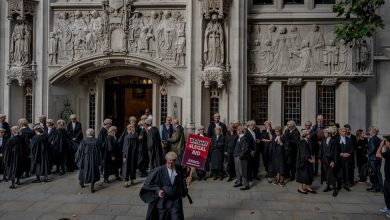How Do Higher Interest Rates Bring Down Inflation?

It’s nasty out there.
Inflation is high, interest rates have been rising and bond and stock prices have plummeted. Predictions of a possible recession are proliferating.
Clearly, this is a difficult moment for anyone who has saved or invested money — or is even thinking about doing so. Many people have questions.
So we invite you to send a brief note, asking whatever you want to know about what’s happening in the markets and the economy and what it may mean for your financial life.
More than 140 questions have already arrived. They coverjust about all of the pressing financial topics, including questions about inflation, the economy’s prospects, the state of the stock, bond and commodity markets, retirement and portfolio issues, and guidance for people who are just beginning to invest or come to grips with the current markets.
Please keep those questions coming. I’ll address as many of them as I can in the weeks ahead.
While I’ve been reporting and writing about finance and investing for more than 20 years, and on other subjects even longer than that, I certainly don’t have all the answers. But I do what journalists always do: Find an expert who does.
How do interest rates affect inflation?
Many questions deal with inflation and interest rates, which is our topic this week.
I’ve gotten help from two experts.
One is Kathy Jones, the chief fixed-income strategist at the Schwab Center for Financial Research. The other is Edmund S. Phelps, a Columbia University economist who won the Nobel in economic science in 2006. He won the prize for his pathbreaking work on the trade-offs between inflation, wages and unemployment, and on how peoples’ expectations about inflation may affect inflation itself.
The central question came from Karen van Kriedt in Marin County, Calif., who wrote: “How does raising interest rates counteract inflation?”
In a subsequent phone conversation, she said she wanted a better understanding of what inflation really is, and of how the Fed’s actions end up affecting inflation in the real world. Her question looks simple but its implications are profound.
Understand Inflation and How It Impacts You
- Inflation 101: What is inflation, why is it up and whom does it hurt? Our guide explains it all.
- Inflation Calculator: How you experience inflation can vary greatly depending on your spending habits. Answer these seven questions to estimate your personal inflation rate.
- Interest Rates: As it seeks to curb inflation, the Federal Reserve began raising interest rates for the first time since 2018. Here is what the increases mean for consumers.
- State Intervention: As inflation stays high, lawmakers across the country are turning to tax cuts to ease the pain, but the measures could make things worse.
- How Americans Feel: We asked 2,200 people where they’ve noticed inflation. Many mentioned basic necessities, like food and gas.
The inflation situation is fairly grim. On Wednesday, the government issued fresh numbers for the Consumer Price Index. Even the good news contained disturbing elements.
For the first time in months, annual inflation moderated in April. It’s possible that, as I’ve been suggesting since February, inflation is near a peak, with the problems caused by the pandemic beginning to ebb. Nevertheless, the C.P.I. still increased at an annual rate of 8.3 percent, which is near its fastest pace since 1981: It’s clearly much too high.
In addition, core inflation — which excludes groceries and gas — picked up 0.6 percent in April from the previous month, faster than its 0.3 percent increase in March. That’s not a good sign.
The Federal Reserve is tightening monetary policy to fight inflation. More precisely, it is raising the short-term interest rate it controls directly, known as the Fed funds rate. It is also reducing its own bond holdings and providing what it calls “forward guidance” — which amounts these days to a series of warnings that interest rates will rise further. The Fed’s actions have contributed to the turmoil afflicting the markets.
How do supply and demand fit in?
As Ms. van Kriedt and I discussed, inflation occurs when too much money chases too few goods. When people have a lot of cash and not that much to spend it on, they often bid up prices. “Like they are doing with houses here in Marin County?” she asked.
Exactly, I said.
Ms. Jones and Professor Phelps explained the mechanics of how inflation works.
So how might raising interest rates help here? One way of looking at rapidly rising prices — a.k.a., a high rate of inflation — is as an imbalance of supply and demand. By raising short-term interest rates, and by influencing rates elsewhere in the economy, the Fed is making it more expensive to borrow money.
Mortgage rates are rising, for example, making it more costlyto buy a house. That may not lower inflation in home prices immediately because the supply of materials and available workers is so tight and demand is so high, mainly because of the pandemic. The Fed can’t do much about those shortages. But as they resolve, perhaps within a year or so, higher interest rates are likely to shift the relationship of supply and demand, lowering the rate of inflation.
Ms. Jones, the strategist at Schwab, put it this way: “By raising rates, the Fed is trying to make you slow down your spending. That happens when the cost of money goes up for a car loan or mortgage or something else you want to spend money on. At some point, you’re going to pull back. The higher cost of money reduces your purchasing power — what you can afford to buy — and the Fed is effectively making you buy less. And that should bring down inflation.”
Similarly, Professor Phelps said, “You can look at our situation as aggregate demand exceeding supply, and that’s causing prices to rise,” so the Fed needs to “clamp down on demand” by raising interest rates.
Sadly, though, he said, if interest rates go high enough for long enough, economic growth will slow and some people will lose their jobs. “When the unemployment rate turns out, after careful analysis, to be very low, and when inflation is high, then we do want to put a lid on it and the Fed does need to raise rates. But that will have consequences.”
An economic slowdown associated with a decline in the rate of inflation could deteriorate into an outright recession. But the Fed is trying to avoid that and engineer a “soft landing” — a state of Goldilocks perfection, in which growth is neither too fast nor too slow, and prices are just right.
Why does the Fed ‘communicate’ so much?
Financial markets are reacting not just to what the Fed does but also to what it says it is going to do. Nick DeClerico of Philadelphia sent in a question about that.
Inflation F.A.Q.
What is inflation? Inflation is a loss of purchasing power over time, meaning your dollar will not go as far tomorrow as it did today. It is typically expressed as the annual change in prices for everyday goods and services such as food, furniture, apparel, transportation and toys.
What causes inflation? It can be the result of rising consumer demand. But inflation can also rise and fall based on developments that have little to do with economic conditions, such as limited oil production and supply chain problems.
Is inflation bad? It depends on the circumstances. Fast price increases spell trouble, but moderate price gains can lead to higher wages and job growth.
How does inflation affect the poor? Inflation can be especially hard to shoulder for poor households because they spend a bigger chunk of their budgets on necessities like food, housing and gas.
Can inflation affect the stock market? Rapid inflation typically spells trouble for stocks. Financial assets in general have historically fared badly during inflation booms, while tangible assets like houses have held their value better.
The Fed’s pronouncements about where it expects interest rates and inflation to go are called “forward guidance.” Mr. DeClerico said he was “wondering why the Federal Reserve feels it necessary to constantly ‘communicate’ future actions to the financial markets.”
This kind of communication was less common 30 years ago. But a series of Fed chairs — Alan Greenspan, Ben S. Bernanke and Janet L. Yellen — expanded the practice. Jerome H. Powell, confirmed for his second term as the leader of the Fed on Thursday, has made itcentral. The Fed uses official statements, publicly disseminated economic projections, speeches, interviews and news conferences to tell the markets where it wants them to be heading.
At this moment, Professor Phelps said, the Fed may be “scaring people in financial markets into believing that they should lower their expectations of inflation.”
He added, “The Fed is saying we should believe the inflation rate is going to fall as a result of the Fed’s efforts.” The idea is that “the markets are already expecting that the Fed is going to succeed in lowering expectations of inflation, and that will lower inflation itself.”
That’s the theory, at least. There’s some evidence that it works. Longer-term interest rates have risen substantially this year, not just as a mechanical response to increases in the Fed funds rate but as a reflection of changing views in the markets of where the Fed wants interest rates and inflation to be a year or two from now.
This approach has a drawback, however. It’s like the old game of telephone. Start by whispering “higher interest rates and a soft landing in the economy” and, before you know it, this message, transmitted from person to person, has become totally different. The Fed’s messages mean different things to different people. Some people are hearing “recession.”
That, in my view, is a major reason for the heightened anxiety and volatility in the markets. There is no stable consensus on where the Fed is going or whether it can get there.
Professor Phelps is skeptical, too. “I have no idea how much importance to attach to that thinking, that forward guidance,” he said. “Lots of people will have their own thoughts about future Fed policy and I’m not sure that their expectations can be directly manipulated in this way, but it’s an interesting question. Really, I don’t know to what extent central banks are effective in altering expectations of inflation, of guiding people to a particular rate of inflation.”
What’s safe, but with good returns?
John England in Springfield, Va., wrote: “I have some money sitting in a low interest savings account that I know is basically losing value due to inflation.” Where, he asked, is a good, safe place to put it? Many readers asked this essential question.
Consider Treasury bonds of one form or another, Ms. Jones said. I Bonds are one possibility for savings of up to $10,000. They are paying 9.62 percent for the next six months, a rate that adjusts with inflation, though the Treasury Direct site, where you buy them, is clunky and has been overwhelmed by rising volume.
Stacy Baker, a reader in Washington, D.C., spent two hours on the site without success but hasn’t given up yet. “It’s a shame,” she said. “It certainly isn’t a state of the art experience. Let me say that.”
Two-year Treasury notes are another reasonable choice, now that they yield about 2.6 percent, far more than a bank account, certificate of deposit or money-market fund. And some investment-grade corporate bonds with maturities of less than five years pay more than 3.5 percent.
These are safe, conservative options. As for far riskier bets, like the stock market, I’ll address them in another column.
The Fed’s efforts to combat inflation are a grand experiment. Like it or not, we’re all part of it.





